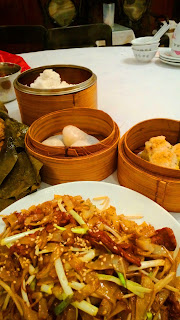Cantonese restaurants' five kinds of food
Hong Kong is the dining capital and the Cantonese restaurants in Hong Kong are the miniature of the culinary capital! You can taste five kinds of food there.(1) DIM SUM (mostly serve from 0700-1700, some restaurants have the night time dim sum)
Dim sum is the many different kinds of exquisite little snacks, buns, dumplings, rolls etc.
The chefs prepare the dim sum by steaming, frying, deep-frying etc.
The main ingredients are pork, shrimp and vegetable.
You may regard dim sum, e.g. the famous shrimp dumpling (Ha Gau蝦餃) and barbecued pork bun (Cha Shao Bao叉燒包), as the hot appetizers.
(2) CANTONESE BARBECUE(serve from 1100)
In most Cantonese restaurants, you can find a kitchen-like room next to the entrance.
You can find lots of barbecue pork, roasted geese, soy sauce chicken etc behind the room's big window.
Busy local workers may buy the lunch boxes there with rice and Cantonese barbecue to take away.
You, the leisure travelers, can order a bowl of rice with chicken or barbecue platter to enjoy in the restaurants.
(3) RICE, NOODLE & RICE NOODLE(serve from 1100)
Apart from the barbecue, the chefs mix the rice, noodle and rice noodle with lots of other ingredients for you.
Like the famous spicy fusion cuisine, fried rice noodle in Singaporean style (Sing Chow Chao Mic星洲炒米), it is made by the barbecue pork, shrimp, chili and onion.
You can also have something in soup, e.g. the rice noodle in soup with roasted goose slice & preserved vegetable (Suet Choi For Ap Si Tong Mic雪菜火鴨絲湯米).
(4) MAIN DISHES(serve from 1100)
The main dishes are the perfect combination of the meat, seafood and vegetable. For example, the chefs can use the grouper to make three dishes for you, fried grouper fillet with celery, steam grouper belly and soup with grouper bone.
The restaurants have different set lunch/dinner menus, which consist of different main dishes, for you to choose.
As the main dishes are made by the best foods, they are more expensive than dim sum.
(5) DESSERT(serve from 1100)
The set lunch/dinner menus always have desserts included.You can also find them on the dim sum menu and order them separately.
Green bean soup(Look Dau Sha綠豆沙), Osmanthus Jelly(Kwai Fa Go桂花糕) etc are common.
Some restaurants can offer you something like the 'mango pudding glutinous rice flour roll' (Mon Guo Law Mic Kuen芒果糯米卷) and Pumpkin Soup(Nam Gwa Lo南瓜露).
Mouthwatering??? No need to find the big brand or the one with Michelin Star, just find one Cantonese restaurant on the main roads/in the malls and you can enjoy all the above-mentioned delicacies.
You may consider the following private tour options, which include the dim sum meal...
Full day Hong Kong Kowloon city tour
Round Hong Kong Island full day private tour
Hong Kong Lantau Island full day private tour
Kowloon half day culture tour
For further private tour planning, please contact Frank the tour guide.

































